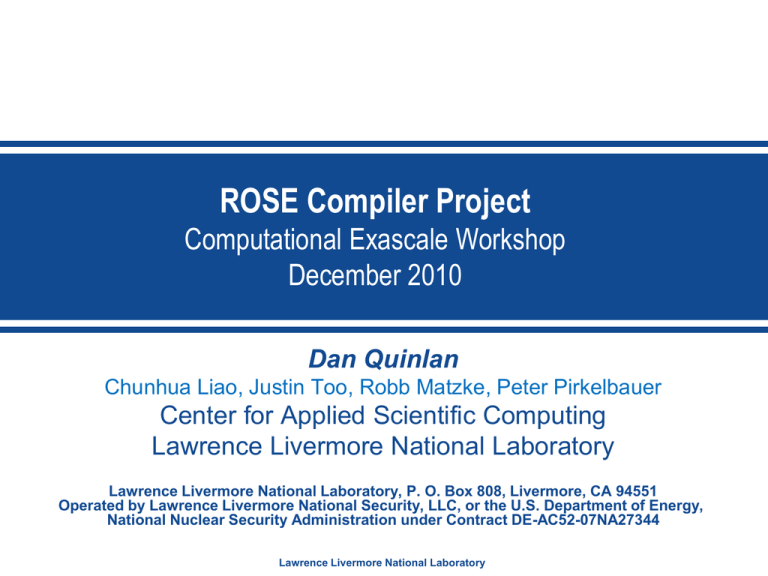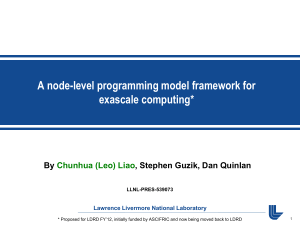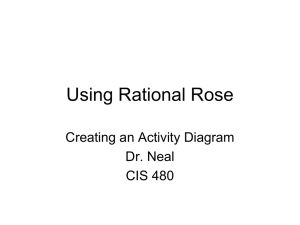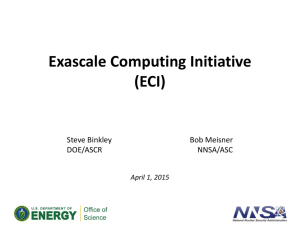ROSE_CASC_Exascale_Workshop_ROSE_v4
advertisement

ROSE Compiler Project
Computational Exascale Workshop
December 2010
Dan Quinlan
Chunhua Liao, Justin Too, Robb Matzke, Peter Pirkelbauer
Center for Applied Scientific Computing
Lawrence Livermore National Laboratory
Lawrence Livermore National Laboratory, P. O. Box 808, Livermore, CA 94551
Operated by Lawrence Livermore National Security, LLC, or the U.S. Department of Energy,
National Nuclear Security Administration under Contract DE-AC52-07NA27344
Lawrence Livermore National Laboratory
ROSE supports custom software analysis tools
Software analysis exposes behavioral properties of large scale software systems
ROSE is an open compiler infrastructure for custom domain-specific analysis
•
Source code: C, C++, Fortran 2003, OpenMP, UPC, PHP
•
Binary executables (Windows and Linux) (x86, Power-PC, ARM)
•
Program analysis uses/generates different graphs
•
Graphs for real software have millions of nodes
•
Graphs are for use in automated analysis (not users)
System-dependency
Sliced-system-dependency
int aFunction(int a, int b)
{
int c=b;
return a;
}
main()
{
int a,b,c,d,e;
int i=4;
for (i=0;i<10;i++)
{
int j=55;
c=i+j;
c=aFunction(i,c);
a=aFunction(a+1,b);
}
#pragma SliceTarget
a;
return 0;
}
Data-dependency
Control-Flow
Science & Technology: Computation Directorate
2
Control-dependency
ROSE is a software analysis and source-to-source
transformation infrastructure for building tools
Source Code
or Binary
Executable
ROSE-based tool
Transformed
Source Code
ROSE
Frontend
Unparser
ROSE
IR
Analyses/
Transformation/
Optimizations
System-dependency
Sliced-systemdependency
ControlControl
flow
Flow
ROSE
Control dependency
Science & Technology: Computation Directorate
3
GOAL: Position ROSE as a Strategic Part of DOE Research
Supports the languages used within DOE (Fortran/C/C++)
The only compiler project within DOE for DOE apps
ROSE targets all of the real-world applications across all of DOE
Used by many national labs:
•
ANL, LANL, LBL, ORNL, PNL, SNL, and LLNL
Used worldwide for external research projects
Supports many other research projects within DOE
Open source (top download on SciDAC web site)
BSD licensed
Fully automated testing and release process
Science & Technology: Computation Directorate
4
Programming Model Research
OpenMP 3.0 compiler implemented using ROSE
• Autoparallelization using OpenMP
UPC source-to-source support within ROSE
Custom analysis and transformation
• MPI (code motion optimizations)
• Basis of DARPA PACE project at Rice
• Co-Array Fortran PGAS programming model (Rice)
• C++ optimization of array language abstractions
• E.g. Intel’s Threaded Building Blocks
Platform for imbedded domain specific language research
• Language extension/restrictions
Exascale specific uses:
• Analysis and transformation for active power control
• Introduction of custom instructions (Co-Design)
• Data layout transformations (Keasler, McGraw)
Science & Technology: Computation Directorate
5
ROSE: Open Source OpenMP 3.0 compiler
OpenMP compiler built using ROSE compiler infrastructure
Research platform for multi-core and parallel programming model research
Unique open source platform for OpenMP research
Demonstrated competitive performance with commercial OpenMP compilers
(as shown below on OpenMP benchmarks: ROSE-GOMP and ROSE-Omni)
speedup
Platform: Dell Precision T5400, 3.16GHz quad-core Xeon X5460 dual processor, 8GB
Benchmarks: NAS parallel benchmark suite v 2.3, Barcelona OpenMP task suite v 1.0
Compilers: ROSE, Omni 1.6, GCC 4.4.1, Mercurium 1.3.3 compiler with Nanos 4.1.4 runtime.
Intel compiler 11.1.059
6
ROSE: Automating Multi-core use for MPI applications
MPI applications have to use multi-core nodes in current and future architectures
Hybrid MPI and Multi-core programming models square the complexity of using
either one separately
ROSE’s new Autopar tool automatically inserts multicore optimizations into
existing MPI applications, automatically detects existing parallelism.
Ongoing work on large scale LLNL applications
Demonstrated performance improvements on application kernels (8x speedup)
Uniquely applicable to loops, standard C++ abstractions, and user-defined types
Platform: Dell Precision T5400, 3.16GHz quad-core Xeon X5460 dual processor, 8GB
Compiler: ROSE OpenMP translator + Omni 1.6 Runtime + GCC 4.1.2
7
ROSE: Autotuning Performance Optimization Research
ROSE has rich support for custom autotuning (plus autotuning documentation)
Specific focus on whole application autotuning (ongoing research with PERI)
Applicable to wide range of Multi-core architectures
Demonstrated superior performance using autotuning (4.14x speedup)
A platform for autotuning research on programming models (results below show
the autotuning of parameters to the OpenMP run-time system to control the depth
of nested parallelism)
s
e
c
o
n
d
s
450
400
350
300
250
200
150
100
50
0
1
2
4
6
8
10
12
1
2
4
8
16
Task queue length multiplier ( mp * 16)
32
64
Platform: Xeon X5570 2.93GHz , 2x4=8 cores with HyperThreading (8x2=16 threads), 12GB
Compiler: ROSE-OpenMP + libgomp of GCC 4.4.4 (modified)
Search space: threads [1,16,2], queue length multiplier: 1, 2, 4, .., 64
Best sequential (n=14):
Best performance:
8 threads, 2*16 = 32 queue len,
131.7 s
31.8 s ( 4.14x)
8
ROSE: Understanding Software for Exascale Co-Design
ROSE communicates subtle software design to architecture design groups
Software characterization for exascale software/architecture co-design
• ROSE measures amount of parallelism in DOE applications
• Classifies types of memory usage to inform hardware designers
• Many other custom requests from exascale design teams for co-design
Instrumentation of applications to assess potential hardware exascale features
ROSE will generate skeleton apps to drive exascale hardware simulators
ROSE Compiler Analysis and Exascale Co-Design Transformations
Control-Flow
main()
{
int a,b,c,d,e;
int i=4;
for (i=0;i<10;i++)
{
int j=55;
c=i+j;
c=aFunction(i,c);
a=aFunction(a+1,b);
}
a;
return 0;
}
System-dependency
Sliced-system-dependency
Dynamic
and
Static
Analysis
Data-dependency
main()
{
int a,b,c,d,e;
int i=4;
for (i=0;i<10;i++)
{
int j=55;
c=i+j;
c=aFunction(i,c);
a=aFunction(a+1,b);
}
#pragma SliceTarget
a;
return 0;
}
Exascale
Design Data
for
Architecture
Team
9
We have developed numerous collaborations through
the ROSE compiler toolset
•DOE Laboratories:
•LLNL (A Div, B Div, Cyber-Security)
•ANL, LANL, LBL, ORNL, PNNL
•DOE Research Programs:
•PERI (SLAC, Fortran/C/C++ Optimization, UT, ANL, ISI, LBL)
•Collaborations:
•DOD (Air Force)
ROSE is winner of 2009 R&D100 award
•NIST(SAMATE)
•CERT (CMU)
ROSE used for graduate courses at
•GrammaTech
•IBM (Program Verification Group)
seven different universities (compiler
•Absint (developers of PAG)
construction to cyber security)
•London Imperial College
•Texas A&M
•Rice University
ROSE being used to build products at
•Vienna University of Technology
five different companies (BSD license)
•University of Tennessee
•Cornell University
•Indiana University
ROSE released at http://www.roseCompiler.org
•University of California at Berkeley
•University of Bergen
Top Download on SciDAC web site…
•University of Maryland
•Friedrich-Alexander-University Erlangen-Nuremberg
•University of Texas at Austin
•UCSD
•UC Davis
Science & Technology: Computation Directorate
10
Economics of compilers…
Vendor compiler teams serve their masters
• Compiler groups are subsidized (~75% from hardware)
• Hardware groups rule, but are often ignored…
• Marketing Department (competitive vendors)
Make the new chips look good
Direct competition against other vendors
There are few non-vendor associated compiler teams
The market for compilers is not really HPC…
A one off machine is not worth changing the compiler to support…
So the compiler you will get is the substantially the same vendor
compiler that exists today (vendor compilers change slowly)
Free compilers are the norm for a lot of HPC work…(GNU)
Science & Technology: Computation Directorate
11









